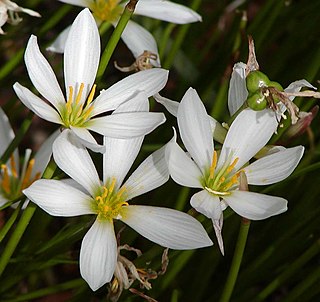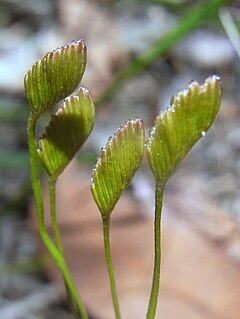
Cymbidium, commonly known as boat orchids, is a genus of evergreen flowering plants in the orchid family Orchidaceae. Orchids in this genus are epiphytic, lithophytic, terrestrial or rarely leafless saprophytic herbs usually with pseudobulbs. There are usually between three and twelve leaves arranged in two ranks on each pseudobulb or shoot and lasting for several years. From one to a large number of flowers are arranged on an unbranched flowering stem arising from the base of the pseudobulb. The sepals and petals are all free from and similar to each other. The labellum is significantly different from the other petals and the sepals and has three lobes. There are about fifty-five species and sixteen further natural hybrids occurring in the wild from tropical and subtropical Asia to Australia. Cymbidiums are well known in horticulture and many cultivars have been developed.

Grevillea is a diverse genus of about 360 species of evergreen flowering plants in the family Proteaceae, native to rainforest and more open habitats in Australia, New Guinea, New Caledonia, Sulawesi and other Indonesian islands east of the Wallace Line. It was named in honour of Charles Francis Greville, an 18th century patron of botany and co-founder of the Royal Horticultural Society. The species range from prostrate shrubs less than 50 cm (20 in) tall to trees 35 m (115 ft) tall. Common names include grevillea, spider flower, silky oak and toothbrush plant. Closely related to the genus Hakea, the genus gives its name to the subfamily Grevilleoideae.

Justicia is a genus of flowering plants in the family Acanthaceae. It is the largest genus within the family, encompassing around 700 species with hundreds more as yet unresolved. They are native to tropical to warm temperate regions of the Americas, India and Africa. The genus serves as host to many butterfly species, such as Anartia fatima. Common names include water-willow and shrimp plant, the latter from the inflorescences, which resemble a shrimp in some species. The generic name honours Scottish horticulturist James Justice (1698–1763). They are closely related to Pachystachys.

Zanthoxylum is a genus of about 250 species of deciduous and evergreen trees, shrubs and climbers in the family Rutaceae that are native to warm temperate and subtropical areas worldwide. It is the type genus of the tribe Zanthoxyleae in the subfamily Rutoideae. Several of the species have yellow heartwood, to which their generic name alludes.

Polypodiaceae is a family of ferns. In the Pteridophyte Phylogeny Group classification of 2016, the family includes around 65 genera and an estimated 1,650 species and is placed in the order Polypodiales, suborder Polypodiineae. A broader circumscription has also been used, in which the family includes other families kept separate in PPG I. Nearly all species are epiphytes, but some are terrestrial.

Hedychium is a genus of flowering plants in the ginger family Zingiberaceae, native to lightly wooded habitats in Asia. There are approximately 70-80 known species, native to India, Southeast Asia, and Madagascar. Some species have become widely naturalized in other lands, and considered invasive in some places.

Calanthe, commonly known as Christmas orchids, is a genus of about 220 species of orchids in the family Orchidaceae. They are evergreen or deciduous terrestrial plants with thick roots, small oval pseudobulbs, large corrugated leaves and upright, sometimes arching flowering stems. The sepals and petals are narrow and a similar size to each other and the labellum usually has spreading lobes.

Zephyranthes is a genus of temperate and tropical plants in the Amaryllis family, subfamily Amaryllidoideae, native to the Western Hemisphere and widely cultivated as ornamentals. There are over 70 recognized species, as well as numerous hybrids and cultivars. Common names for species in this genus include fairy lily, rainflower, zephyr lily, magic lily, Atamasco lily, and rain lily.

Staphylea, called bladdernuts, is a small genus of 10 or 11 species of flowering plants in the family Staphyleaceae, native to temperate regions of the Northern Hemisphere. The highest species diversity is in China, where four species occur.

Aechmea is a genus of flowering plants in the family Bromeliaceae. The name comes from the Greek aichme, meaning "spear". Aechmea comprises eight subgenera and around 250 species distributed from Mexico through South America and the Caribbean. Most of the species in this genus are epiphytes.

Corybas, commonly known as helmet orchids, is a genus of about 120 species of plants in the orchid family, Orchidaceae. Helmet orchids are small, perennial, deciduous herbs and are nearly always terrestrial. They have a single leaf at their base and a single flower on a short stalk, the flower dominated by its large dorsal sepal and labellum. Species of Corybas are found in Australia, New Zealand, New Guinea, Southeast Asia, the Himalayas, southern China, many Pacific islands and a few sub-Antarctic islands.

Woodwardia is a genus of ferns in the family Blechnaceae, in the suborder Aspleniineae of the order Polypodiales. Species are known as chain ferns. The genus is native to warm temperate and subtropical regions of the Northern Hemisphere. They are large ferns, with fronds growing to 50–300 cm long depending on the species.

Gastrochilus, abbreviated Gchls in horticultural trade, is a genus of plant in family Orchidaceae. It is native to eastern and southeastern Asia, including China, Japan, Bangladesh, Thailand, Malaysia, Indonesia, the Philippines, etc.

Olax is a plant genus in the family Olacaceae. The name derives from the Latin, olax (malodorous), and refers to the unpleasant scent of some of the Olax species.

Melica is a genus of perennial grasses known generally as melic or melic grass. They are found in most temperate regions of the world.

Pinalia, commonly known as gremlin orchids, is a genus of flowering plants in the family Orchidaceae. Orchids in this genus are large epiphytic or lithophytic plants with prominent pseudobulbs, each with up to three thin, flat leaves and cup-shaped, relatively short-lived flowers with scale-like brown hairs on the outside. There are about 120 species occurring from tropical to subtropical Asia to the south-west Pacific.

Schizaeaceae is a family of ferns in the order Schizaeales. In the Pteridophyte Phylogeny Group classification of 2016, it includes only two genera. Alternatively, two families kept separate in PPG I, Lygodiaceae and Anemiaceae, may be included in Schizaeaceae so that the family has four genera. In this approach, the Schizaeaceae of PPG I is treated as the subfamily Schizaeoideae.

Red Bluff Air Force Station is a closed United States Air Force General Surveillance Radar station. It is located 4.3 miles (6.9 km) west-southwest of Red Bluff, California. It was closed in 1970.
Craibiodendron is a genus of flowering plants belonging to the family Ericaceae.

















